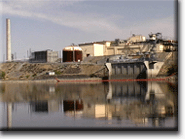 |
 |
Radioactive Waste In Columbia Riverbed To Be Checked By Ecology Department
|
|
|
Hanford's N-Reactor on the
shore of the Columbia River TRAC Home About TRAC Reports/Videos Archive Resources Search |
Since 1999, Norm Buske, director of TRAC, a public-interest organization that monitors U.S. nuclear facilities, has reported wastes from Hanford’s uranium-233 production in the Hanford Reach riverbed. Ten major salmon spawning areas are located in the riverbed under the Hanford Reach – the 50 mile stretch of the Columbia River that flows through the Hanford site in eastern Washington State. Radioactivity from uranium-233 produced for mini-nuclear weapons increases over time, as it decays into radium-225. Radium-225 is soluble in riverbed water and mimics calcium, an element essential for animal life. Buske theorizes that the radium-225 increasing in the riverbed water is responsible for the high incidence of gender switching of fall chinook salmon spawning in the Hanford Reach. In 2001, researchers from the University of Idaho reported that 80% of female fall chinook salmon from the Hanford Reach had gender-switched from males. Gender switching is caused by environmental stress during the early stages of salmon development. Newly hatched salmon live in the riverbed for months as they develop and absorb their egg sacs. While the hatchlings live in the Hanford Reach riverbed, they are subject to radioactive and toxic wastes that remain from DOE’s production of nuclear weapons materials in Hanford reactors during the Cold War. The hatchlings are also subjected to chemicals and heavy metals dumped into the Columbia River from industrial, municipal, and agricultural sources. Fall chinook salmon spawning in the Hanford Reach are vital to the long-term strength of the billion-dollar-a-year fishery. TRAC provided its radiological findings to Ecology’s Nuclear Waste Program staff in April. After review, Ecology decided to sample the riverbed for uranium-233 wastes during low river levels this year. Ecology will publish its results after the samples are analyzed. If Hanford’s uranium-233 waste is threatening Columbia River salmon, the DOE might be required to remediate, as part of on-going clean-up of the federal site.
|